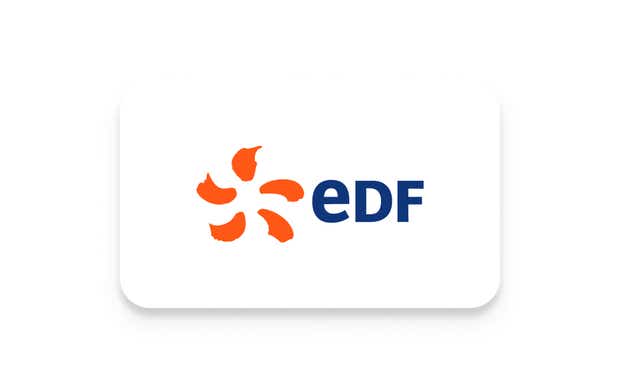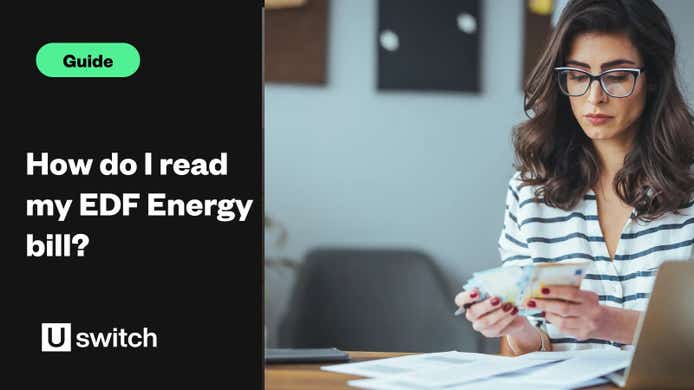EDF Energy tariffs, prices, reviews and other information
Find out about EDF - one of the UK's big six energy suppliers and a significant producer of low-carbon electricity - here.
Why choose EDF Energy?
EDF has been one of the UK’s big six energy suppliers almost since it was founded in 2003. The French energy company, EDF Group (Électricité de France), bought Seeboard, London Energy and SWEB Energy and formed EDF as a UK energy supplier. The supplier is the UK’s largest producer of low-carbon electricity and the biggest supplier of electricity by volume in Great Britain.
As of the end of 2024, EDF Energy supplied 10.5% of the UK electricity market and 8.7% of the gas market.
Security of a large supplier
A range of competitive tariffs
Access to energy efficiency and home improvement help
Sell excess generated electricity back to the grid
How do I contact EDF?
There is a range of methods that customers can use to contact EDF:
- Phone: 0333 006 9950 (Monday to Thursday 8am-6pm, Friday 8am-4pm) for those who pay by Direct Debit, cash or cheque. Prepayment customers can call 0333 200 5100 (Monday to Friday, 8am-6pm)
- Email: hello@edfenergy.com
- Text: 0748 058 9950 (alternatively, the WhatsApp number is 07480 589 950).
What tariffs are offered by EDF?
Fixed energy tariffs
The unit rates and standing charges for a fixed tariff don't change for the duration of the contract, meaning they’re not affected by wholesale market or price cap fluctuations. However, if you want to leave a fixed tariff early, you’ll usually have to pay an exit fee.
Standard variable energy tariffs
Standard variable tariffs are subject to the price cap, so unit rates can go up or down depending on what's happening with wholesale energy prices.
Air source heat pump tariffs
These tariffs are only available for customers with air source heat pumps,. They offer two cheaper periods of electricity for those with air source heat pumps, and tracks and adjusts unit rates based on price cap fluctuations. There’s more information available on EDF’s website for those interested in signing up.
EV energy tariffs
EV energy tariffs are fixed price time-of-use tariffs designed to provide cheaper home charging for electric vehicle owners. You'll usually be required to have a smart meter before you can sign up to a tariff like this.
Does EDF charge exit fees?
EDF Energy does charge exit fees on its fixed tariffs, in line with other energy suppliers. At the time of writing, these ranged from £50 to £250.
Have EDF prices risen in 2025?
In 2025, EDF standard variable prices have risen twice in line with the energy price cap, with standard variable tariffs capped at £1,849 until 1 July. However, prices will then fall with the price cap to £1,720.
Can I do anything about EDF price rises?
All EDF customers with a standard variable tariff are impacted by price changes. If you're on a fixed plan from EDF, your rates stay the same for the remainder of the contract. But remember that you'll automatically be rolled onto a standard variable tariff when your fixed deal ends.
If you’re on a standard variable tariff and want to see if you can switch to a fixed deal, run an energy comparison by entering your postcode below.

Run an energy comparison
Click here to compare energy prices and get started on your energy switch.
EDF Energy reviews 2025
As of June 2025, EDF has a score of 4.7 from over 141,000 reviews. A lot of customer reviews single out the supplier's app and Home Hub as particularly good as a means of tracking energy usage and spend.

Can I get a smart meter with EDF?
Yes, EDF offers smart meter installation to its customers. They come with an In-Home Display so it's easy to see how much energy you've used and how much you've spent each day.
What are EDF's other products and services?
Gas and electricity supply is a small part of EDF’s overall energy offering to customers throughout the UK. The supplier also offers:
- Boiler cover
- Home electrics cover and repair
- Air source heat pump installation
- The ability for customers to earn money for selling excess home-generated energy back to the grid
- Air conditioning unit installation
- Home charging points for electric vehicles
- Electric vehicle leasing
Can I get business energy from EDF?
Yes - EDF Energy is one of the largest suppliers of gas and electricity to UK businesses. It offers a range of price plans to suit businesses of all sizes, in all industries, including a flexible, short-term deal designed to support start-ups or any business moving into a new property.
EDF Energy’s business gas and electricity service offer all customers the following features:
- 24/7 access to our online management tool MyAccount and App
- 7% discount for paying monthly by Direct Debit
- 24/7 access to Live Chat for existing customers
- Free dedicated UK business advisers.
Frequently asked questions
Does EDF offer renewable energy?
EDF, as well as being one of the biggest energy suppliers in the UK overall, is also the UK's biggest producer of zero-carbon electricity thanks to its operation of 10 nuclear power plants and 36 wind farms around the UK. It was also the energy and sustainability partner of the London 2012 Olympic and Paralympic Games.
Does EDF Energy offer energy efficiency products?
EDF offers a range of solutions for customers looking to invest in energy efficiency products. These include:
- Boilers
- Air source heat pumps
- Solar panel systems
- Solar batteries
- Insulation.
Does EDF Energy have an app?
EDF does have an app that allows customers to check their account details, submit meter readings and make changes in addition to paying bills. It also uses fingerprint log-in for extra security. The Hub feature within the app shows a property's energy usage and provides tips on how to save energy.
Prepayment customers can also check their balance, top up and get alerts through the app.
Which providers are similar to EDF Energy?
Any large supplier is probably fairly similar to EDF Energy, especially if they offer a comparable range of energy efficiency products. The likes of British Gas and Octopus could be considered the closest alternatives to EDF.
How do I cancel my EDF Energy supply?
If you want to cancel your energy supply from EDF, you can do so at any time. But remember that you’ll have to pay an exit fee if you’re on a fixed tariff and not within the final 49 days of your contract. Simply switch to a new energy deal and your EDF supply will be cancelled as a result.
Is EDF Energy going bust?
It’s very unlikely that a supplier as large as EDF will go bust, particularly because it’s ultimately backed by the French state. However, the energy market is challenging and unpredictable at the moment and there is a certain level of risk to some suppliers - find out why in our energy market Q&A guide.
Read more




